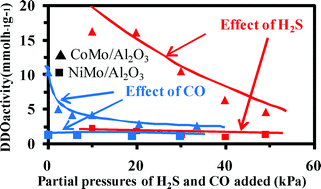Effect of H2S and CO on the transformation of 2-ethylphenol as a model compound of bio-crude over sulfidedMo-based catalysts: propositions of promoted active sites for deoxygenation pathways based on an experimental study
Abstract
Promoted (

* Corresponding authors
a
UMR CNRS 6503, Laboratoire de Catalyse en Chimie Organique, Université de Poitiers, 40 avenue du Recteur Pineau, Poitiers Cedex, France
E-mail:
frederic.richard@univ-poitiers.fr
Fax: +33 5 4945 3899
Tel: +33 5 4945 3519
Promoted (

 Please wait while we load your content...
Something went wrong. Try again?
Please wait while we load your content...
Something went wrong. Try again?
C. Bouvier, Y. Romero, F. Richard and S. Brunet, Green Chem., 2011, 13, 2441 DOI: 10.1039/C1GC15181A
To request permission to reproduce material from this article, please go to the Copyright Clearance Center request page.
If you are an author contributing to an RSC publication, you do not need to request permission provided correct acknowledgement is given.
If you are the author of this article, you do not need to request permission to reproduce figures and diagrams provided correct acknowledgement is given. If you want to reproduce the whole article in a third-party publication (excluding your thesis/dissertation for which permission is not required) please go to the Copyright Clearance Center request page.
Read more about how to correctly acknowledge RSC content.
 Fetching data from CrossRef.
Fetching data from CrossRef.
This may take some time to load.
Loading related content
